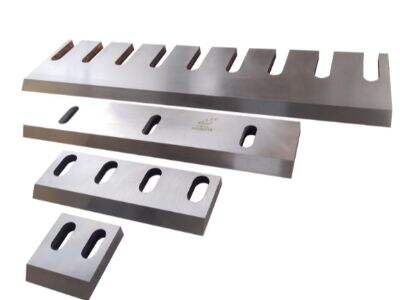กิ่งไม้เป็นของเสียธรรมชาติจากการจัดภูมิทัศน์และการทำป่าไม้ แต่เครื่องบดไม้สามารถย่อยสลายพวกมันให้กลายเป็นชิปไม้ที่มีประโยชน์ ซึ่งสามารถนำไปใช้เป็นปุ๋ยหมัก (composting) เป็นฟางคลุมดิน หรือ "spread" สำหรับทางเดิน หรือการผลิตพลังงานชีวภาพ การใช้งานและความทนทานของเครื่องเหล่านี้ขึ้นอยู่กับวัสดุที่ใช้ในใบมีดเป็นหลัก เราอยากสำรวจโลกของใบมีดเครื่องบดไม้ให้ลึกซึ้งมากขึ้น และระบุวัสดุที่พบได้ทั่วไปที่สุดที่ใช้ในการผลิตชิ้นส่วนเครื่องจักรที่รับประกันความคงทนและประสิทธิภาพสูงสุด
โลหะผสมที่ดีที่สุดสำหรับประสิทธิภาพของใบมีดเครื่องบดไม้
ในการเลือกวัสดุที่เหมาะสมสำหรับใบมีด คุณต้องหาสมดุลระหว่างความแข็งและทนทาน โดยยังคงรักษาความสามารถในการต้านทานการสึกหรอและการกัดกร่อน ซึ่งเหล็ก D2 อ้างว่าทำได้ดีมาก! จากตัวเลือกที่มีอยู่ เหล็กLOY มีข้อได้เปรียบเหนือโลหะบริสุทธิ์มากกว่า เหล็กคาร์บอนสูง เหล็กกล้าไร้สนิม เหล็กเครื่องมือ และส่วนผสมที่ต้านทานการสึกหรอ เป็นที่นิยมมากสำหรับประสิทธิภาพที่มอบให้ภายใต้เงื่อนไขที่เข้มงวดเช่นนี้
ความโดดเด่นของเหล็กคาร์บอนสูงในใบมีดสำหรับตัดไม้
ผู้คนจำนวนมากเลือกใช้เหล็กกล้าคาร์บอนสูงเป็นวัสดุที่ต้องการเนื่องจากมันให้สมดุลที่ยอดเยี่ยมระหว่างความแข็งแรงและความเหนียว เกรดนี้มีปริมาณคาร์บอนอยู่ในช่วง 0.6% ถึง 1.5% ส่งผลให้มีความแข็งมากขึ้น แต่ลดความยืดหยุ่นลงเล็กน้อยเมื่อเทียบกับเหล็กกล้าคาร์บอนต่ำ คุณสมบัตินี้มีความสำคัญสำหรับใบมีดของเครื่องตัดไม้ที่จะต้องทนต่อแรงกระแทกจากไม้ท่อนหนักและยังคงรักษาคมของมันไว้ได้ นอกจากนี้ สามารถเชื่อมเงินและทำการอบเพื่อเพิ่มความแข็งเพื่อรองรับการแบกรับน้ำหนักที่ดีขึ้น
ประสิทธิภาพยอดเยี่ยมของเครื่องตัดไม้พร้อมด้วยใบมีดสเตนเลส
ประการที่สอง แม้ว่าขอบของสเตนเลสจะไม่แข็งเท่ากับใบมีดคาร์บอนสูง แต่พวกมันต้านทานการเกิดสนิมได้ดีมาก จึงเหมาะสมสำหรับใช้งานในสภาพแวดล้อมที่ชื้นหรือเปียกน้ำ คุณสมบัตินี้ยังช่วยให้คุณป้องกันการสะสมของสนิม ทำให้ใบมีดยังคงคมเหมือนมีดโกนและทำงานได้อย่างมีประสิทธิภาพ ใบมีดสเตนเลส โดยเฉพาะอย่างยิ่งที่ผลิตจากเกรด เช่น 420 หรือ 304 จะมีการแลกเปลี่ยนระหว่างความต้านทานการสึกหรอและความเหนียว เหมาะสำหรับเครื่องบดไม้ที่ใช้งานเบาหรือเครื่องจักรที่ใช้ในสภาพแวดล้อมชายฝั่งที่จะถูกสัมผัสกับน้ำเค็ม
ทำไมเหล็กเครื่องมือถึงมีข้อดีในการทำใบมีดบดไม้
เหล็กเครื่องมือ เช่น D2 หรือ M2 ถูกออกแบบมาสำหรับใช้งานในแอปพลิเคชันที่มีการสึกหรอสูงมาก โดยที่คุณต้องการขอบที่สมบูรณ์แบบสำหรับแผนที่เขตแดน พวกมันประกอบด้วยคาร์บอนในปริมาณที่สูงกว่าโลหะผสมส่วนใหญ่ และยังมีธาตุอื่นๆ ที่ใช้ในการหล่อ เช่น โครเมียม ทังสเตน หรือแวนาเดียม ซึ่งเพิ่มความต้านทานการสึกหรอและความทนทานต่ออุณหภูมิ สิ่งนี้เป็นประเภทของเหล็กคาร์บอนสูงที่ต้านทานความเสียหายจากแรงกระแทกทางกายภาพและให้ความทนทานเพิ่มขึ้นสำหรับการใช้งานในกระบวนการตัดที่มีแรงหนักเกิดขึ้นอย่างสม่ำเสมอ แม้ว่าจะต้องการกระบวนการอบร้อนที่เข้มงวดกว่า และมักจะมีราคาแพงกว่าเหล็กคาร์บอนสูงหรือเหล็กกล้าไร้สนิมในระยะยาว แต่ความทนทานที่เพิ่มขึ้นและการลดค่าใช้จ่ายในการเจียระไนมักทำให้การลงทุนครั้งนี้คุ้มค่า
คู่มือฉบับสมบูรณ์สำหรับชิ้นส่วนที่สึกหรอสำหรับใบมีดบดไม้
ในสภาพแวดล้อมที่มีการสึกหรอสูงมาก วัสดุมาตรฐานของใบมีดอาจไม่เพียงพอ นี่คือจุดที่วัสดุทนการสึกหรอพิเศษเข้ามาช่วย เช่น ใบมีดปลายคาร์ไบด์ Wolfram จะประกอบด้วยตัวโครงสร้างเป็นเหล็ก และมีแท่ง Wolfram แท้ที่มีความทนทานต่อการสึกหรอมากกว่าเดิม ทำให้สามารถใช้งานได้นานขึ้น แม้ว่าคาร์ไบด์จะมีราคาสูงกว่าเมื่อซื้อครั้งแรก แต่มันสามารถใช้งานได้นานกว่าใบมีดเหล็กแบบปกติหลายเท่า ทำให้ลดเวลาหยุดทำงานและการบำรุงรักษาลง ส่วนใบมีดเซรามิก มีโอกาสแตกหักได้ง่าย (เซรามิกเป็นวัสดุที่เปราะมาก) จึงไม่เหมาะสำหรับการใช้งานทั่วไป อย่างไรก็ตาม เซรามิกยังมอบระดับการทนการสึกหรอที่ยอดเยี่ยม โดยเฉพาะในกรณีที่ความเสี่ยงของการเกิดสนิมต่ำ
ดังนั้น สามารถกล่าวได้ว่า การเลือกวัสดุของใบมีดสำหรับเครื่องบดไม้จะมีผลทั้งในระยะสั้นและระยะยาวในแง่ของประสิทธิภาพของเครื่องและต้นทุนในการดำเนินงาน เหล็กคาร์บอนสูง: เป็นวัสดุที่มีสมดุลของคุณสมบัติดีเยี่ยม และปรากฏอยู่ในมีดหลายประเภท; เหล็กกล้าไร้สนิมช่วยกำจัดปัญหาเรื่องสนิมได้ เมื่อใช้กับวัสดุที่ต้องการสำหรับชิ้นส่วนการผลิตหนัก เหล็กเครื่องมือให้ความทนทานที่ดีที่สุด ในขณะที่ตัวเลือกที่ปลายมีดเคลือบคาร์ไบด์ หรือแม้แต่มีดเซรามิก สามารถให้ประโยชน์มหาศาลเมื่อความต้านทานการสึกหรอเป็นสิ่งสำคัญ การรู้ว่าคุณจะใช้เครื่องบดไม้เพื่ออะไรและสร้างสมดุลระหว่างข้อดีของแต่ละวัสดุ เป็นส่วนสำคัญที่ช่วยเพิ่มประสิทธิภาพการทำงานของเครื่องบดไม้ ซึ่งอาจช่วยประหยัดเวลาจากการทำงานหนักเกินไปบางครั้ง

 EN
EN
 AR
AR BG
BG HR
HR CS
CS DA
DA NL
NL FI
FI FR
FR DE
DE IT
IT JA
JA KO
KO NO
NO PL
PL PT
PT RO
RO RU
RU ES
ES SV
SV CA
CA TL
TL ID
ID LV
LV SR
SR SK
SK VI
VI MT
MT TH
TH TR
TR FA
FA AF
AF GA
GA CY
CY LO
LO LA
LA NE
NE SO
SO MY
MY KK
KK